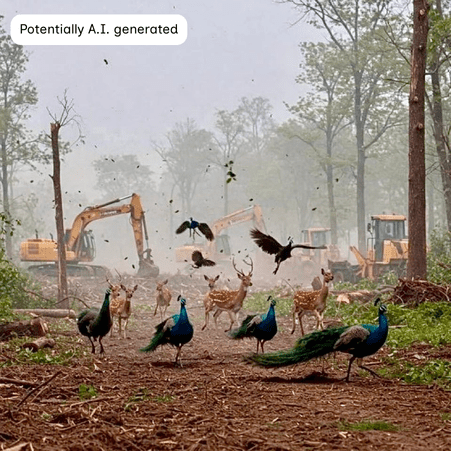
By Susan Haris, Birla Institute of Technology & Science – Pilani

The destruction of the forests in Gachibowli near the University of Hyderabad (HCU) in India raises pressing questions about the ethics of land use, ecological responsibility, and the status of nonhuman animals in moral and development discourses[1] . At the heart of this conflict is Kancha Gachibowli, a patch of semi-forested land that, while not officially classified as a forest, supports over 455 species of flora and fauna and plays a vital role in the campus’s ecological life. The student protesters opposed what they described an unauthorised tree-felling arguing that it is home to vibrant nonhuman life and that it is an integral part of their campus identity in an urban city. The Supreme Court has ordered an immediate stop to all tree-felling activities in the region and strongly criticised the Telangana government’s actions. The government has already systematically cleared around 100 acres for purported infrastructure projects, prompting student protests and public debate. It now plans to auction 400 more acres to build an IT Park, citing promises of major investment and significant employment potential.
This essay examines the ecological and ethical stakes of forest destruction in Gachibowli by connecting it to questions of definition, community and education. What does it mean to care for more-than-human life in an era of developmental violence? What happens when a small fragment—just a patch—is the forest? These aching questions are connected to the student protests and the state violence that was unleashed on them in April 2025, as students appealed to the government for the forests to be protected and affirmed the deer and other animal life as moral friends, as kin. I teach at a university in Hyderabad, and in a world where the younger generation is often seen as uninterested in the environment, I have been thinking that their resistance is a response to the world we are building for them.How can we understand this solidarity with the wild? In a nation that once witnessed the realisation of Tagore’s vision of forest-based learning, where education was meant to unfold in close communion with nature as seen in his tapovan model at Santiniketan, what are the implications of development-led destruction on education?
One of the points of contention between the government and the people is whether the contested land qualifies as a forest. The Indian government does not have a single, universally accepted definition of a forest, relying instead on multiple legal and administrative interpretations. The Indian Forest Act, 1927, classifies forests as Reserved, Protected, and Village Forests, focusing on legal ownership and forest produce management rather than ecological characteristics. The Forest Conservation Act (FCA), 1980 defines forest as any area that is statutorily recognized as a forest, including reserved, protected, or other legally designated forest lands to regulate its diversion for non-forest use. Meanwhile, the Forest Survey of India (FSI) assesses forest cover based on satellite imagery, categorizing forests by canopy density rather than legal status (satellite images shared on twitter of a “before” and “after” of the HCU forests graphically attest to this devastation). The definition of forests has long been contested due to state control, which has often ignored the cultural and livelihood significance of forest spaces for Indigenous (Adivasi) communities. This exclusion, which restricted access and criminalized traditional forest use by Adivasi and other forest-dwelling communities, was partially addressed by the Forest Rights Act of 2006. The 2023 amendment to the Forest (Conservation) Act, 1980, which renamed the Act as the Van (Sanrakshan Evam Samvardhan) Adhiniyam, 1980 restricted the legal definition of forests to only those that are notified under the Indian Forest Act, 1927 excluding unrecorded forests which are around 28% of India’s forest cover. More recently, the Supreme Court’s interim order (February 19, 2024) has directed the government to adopt the broader definition from T.N. Godavarman Thirumulpad v. Union of India (1996), which interpreted “forest” in its dictionary sense to include all land with natural tree cover, irrespective of ownership or classification.
State government records indicate that the land is not classified as forest in either forest or revenue documents. Telangana officials argue that Kancha means unused land and that Kancha Gachibowli is in fact a Kancha Poramboke, a wasteland or grazing land. There are in fact various provisions within the Acts mentioned above to reappropriate wastelands as forests to protect and preserve them. This idea of re-foresting land aligns with recent efforts in environmental thought to attend to fragmented and uneven landscapes. Thinking with Anna Tsing and her colleagues (2019), we might understand Kancha as a kind of patch, a fragmented forest space that stands out from its surroundings and supports forms of life that persist in uneven landscapes shaped by industry and development in the “patchy Anthropocene” (Tsing, Mathews, and Bubandt 2019). A patch is a space that stands out from its surroundings, and this term highlights how human and nonhuman life continues in messy and vital ways that harbour subtle, resilient ecologies. Tsing’s framing thus challenges India’s legal definitions of forest, which often depend on fixed land-use, spatially determined categories, by focusing instead on the ecological significance and social meaning of spaces that fall outside formal recognition. A patch cannot be discerned very well from the top of a mountain; patches become visible through careful field observation at the grassroots (Tsing et al 2024).
The students are keen observers. The widespread protests against the land auction suggest that they see it as a forest. For them, there is no doubt that it is a forest. The Gachibowli forests are symptomatic of the patchy Anthropocene, composed of anthropogenic land-use structures that are fragmented and degraded due to both planned and unplanned landscape changes. Like JNU or NEHU, the forested area is the most striking aspect of the Hyderabad Central University campus. The students claim the forest as theirs, and in the protests following the government order, many have been beaten and arrested by the police. The area remains heavily guarded at the time of writing of this essay. One of my students who lives nearby told me she saw about three police vans, with the officers sitting around drinking chai.
The middle class and visitors to the forest also see it as a forest. On weekends, even though it is not a designated national park, there is a sense of informal protection and public ownership, like the Ridge in Delhi, as people walk and trek in these spaces, which offer an alternative to development-driven options like malls, especially for those who cannot afford them. These so-called wastelands have thus become an evolved public good that people actively use. The students I spoke to all referred to Kancha Gachibowli as the “green lungs” of the city, fully aware of the forest’s ecological value. One of them told me that Hyderabad would actually become a wasteland if these forests were cleared. (Since I taught T.S. Eliot this semester, the poignancy was not lost on me).
What is important to note here is that the Kancha Gachibowli forests are located near some of the most valuable real estate in Hyderabad, and perhaps even in India, given the city’s rapid development. They lie right next to HITEC City, home to numerous corporate offices and companies, marked dystopically by the presence of that emblem of contemporary modernity, Ikea. Sandwiched between the financial business district and Hyderabad Central University, the opportunities for “developing” this area appear endless. More corporate offices can be built, residential apartments with token access to green space can be constructed, and the area can attract additional national and international investment. Unlike the definition of “forest”, which remains under dispute, the monetary value of the HCU forests is uncontested. Many have alleged that the “alarming urgency” behind the forest’s destruction, as noted by the Supreme Court, is linked to the current Chief Minister, Revanth Reddy, who is believed to be profiting from the deal in anticipation of not returning to power due to anti-incumbency.
There is also the toxic legacy of Patancheru, an industrial area located on the outskirts of Hyderabad in Telangana, India. In 2010, Patancheru-Bollaram was classified as a Critically Polluted Area with a CEPI (Comprehensive Environmental Pollution Index) score of 70.7, after which environmental clearances were halted in areas identified by the Central Pollution Control Board (CPCB) (Telangana State Pollution Control Board 2019). Patancheru became an industrial hub in the 1980s as part of state-led efforts to promote growth in sectors such as pharmaceuticals, bulk drugs, chemicals, and manufacturing. Residents have occasionally pointed out to me factories emitting black smoke, and many have said that animals in the area, especially birds, suffer broken bodies due to the poor quality of air and water. However, Patancheru is classified as part of the city’s outskirts so that Hyderabad’s AQI is not officially affected. If the 400 acres of forest are razed, Hyderabad could face a similar fate, with contaminated groundwater and degraded soil from industrial effluents.
However, this is not only a matter of environmental degradation. The student protests have repeatedly drawn attention to the fact that these forests are home to wildlife. The wasteland theory is therefore refuted on two counts: first, because people who live here view it as a patchy forest; and second, because wildlife dwells in these forests. One image that has haunted me is a photograph that is perhaps generated by AI. It is chaotic in its sylvan colours and movement, almost harmonious were it not so destructive. In the photograph, JCBs tear through the trees in the background while deer and peacocks, caught in the confusion move towards us, exposing their mortality and vulnerability in the face of violent eviction. It is a truly uncanny image because it constitutes an imagination of death (Diamond 2006: 99). The flutter of wings and the puzzlement of the animals leave uncertain what becomes of these beings. It is ghostly because the reality has changed; the animals no longer have the forest.
Of course, a particularly poignant refrain of the student protests has been that the animals have nowhere to go now. In not recognising the Kancha Gachibowli forests as forest, the government betrays the histories, agencies and sociality of these animals who have lived alongside humans in the few remaining spaces available to them. Videos show that the tree-felling continued even as officials heard the cries of animals, revealing a clear disregard for animal life. This familiar tension between development and biodiversity operates along the axis of moral strangeness, where wildlife living in these forests are rendered as moral strangers and excluded from ethical consideration. The term “moral stranger,” coined by H. Tristram Engelhardt, refers to a being who does not share the same fundamental moral framework or values as a given ethical community, making mutual understanding and moral reasoning difficult (1996 qtd. in Rose 2008). The government’s attempt to erase these forests is a symptom of moral strangeness, where nonhuman life is positioned as expendable and invisible in the pursuit of developmental priorities. It is also what instantly turns wildlife into villains when human-wildlife conflict inevitably arises as displaced animals enter human-inhabited areas in search of new homes and food.
This is what loss looks like in the Anthropocene. Deborah Bird Rose wonders why death in the Anthropocene is so tragic when death is a natural part of the cycle of life. She suggests that it is because we are witnesses to double death where instead of making space for renewal, it overwhelms ecosystems so completely that they cannot recover. It marks not just the end of individual lives, but the breakdown of entire systems with extinctions outpacing evolution, relationships across species and generations collapsing, and the loss of any future where life might flourish again. It is death without regeneration, a kind of ecological and temporal fissuring that leaves behind a lifeless, uninhabitable world. It is the result of the “monological will” that cannot perceive what moral friends look like and turns away from the cries and calls of fleeing deer and peacocks. Compensatory afforestation will not bring back the home that is already lost. Isn’t that why we hold on to our homes, why the concept of home holds us in its thrall, and why we dream of building a home of our own? In the Indian Anthropocene, the forest, or the wild, is “not a metaphor; it is a glimpse, a sudden flinch-making demonstration, that self without other is no self at all, in fact, is a bare gully where life washes away or bleeds out, where betrayal replaces connectivity, and less and less care remains” (2008: 53). Small wonder, then, that the student protesters called it environmental treason and murder.
What do we teach our students in a hellscape where we tout environmental protection but militarily enforce the very opposite? The moral clarity that the students demonstrated through the protests in spite of police brutality shows us that there is still hope. This moral alliance is based on affection and care; an aesthetic of “shimmering” that glints through when the worlds you love are being destroyed (Rose 2017). Rabindranath Tagore’s ashram school, Santiniketan, modelled after the ancient forest schools of India, embodied such a virtue. As a model of education, it promoted a oneness with nature while living simply and unencumbered by social conventions (2007). Tagore’s vision was relational, like that of the forest dwellers in ancient India, for whom nature and everyday environs were enmeshed and entwined with both material and spiritual needs. The love and reverence for the forest hermitage was the dominant ideal that moulded the “mind of India” in the ancient world (2007: 657). I think with this vision to understand the student protests against deforestation not only as political resistance but also as an assertion of an alternative educational ethic within a public university in India; one that inevitably involves immersion in ecological life-worlds.
For Tagore, forest life is the “vital centre” of social existence which, in its multispecies character, sustains all aspects of thought and action (2007: 521). The solitude of the forest is where the chasm between humans and the rest of creation is bridged. The ideal of forest education was not the suppression of activity but the cultivation of deep harmony between oneself and one’s surroundings through a passionate immersion in the world. The students’ defence of the Gachibowli forests resonates with this ideal, as they enacted a multispecies ethics grounded in presence and protection. Their refusal to treat the forest as an empty or inert space echoes Tagore’s educational commitment to ecological belonging. In standing with the animals, they revived an ancient pedagogical lineage rooted in care, relation, and moral imagination.
In a way, it is a lesson taught by the forest, a lesson derived from living in the forest. All HCU students and alumni I have met become animated when they talk about the beauty of the university. They speak of the lakes within the campus, the deer and other animals, and the entire world that awaits in the heart of the city. It is a relationality inescapable for those who have lived there, and therefore a reality that cannot be auctioned off so easily. The student protesters remain attuned to this connectivity.
Diamond, Cora. 2006. “The Difficulty of Reality and the Difficulty of Philosophy.” In Reading Cavell, edited by Alice Crary and Sanford Shieh, 1st ed., 98–118. Routledge.
Engelhardt, Tristram Jr. 1996. The Foundations of Bioethics. 2nd ed. Oxford University Press.
Express News Service. 2025. “Supreme Court Stays Clearing of 400-Acre Green Cover near Hyderabad University, Seeks Report from HC Registrar.” The Indian Express, April 4, 2025. https://indianexpress.com/article/india/supreme-court-stays-tree-felling-kancha-gachibowli-area-telangana-9922091/.
Rahul, N. 2025. “Decoding the Land Fiasco Behind Controversial Deforestation and Protest at Hyderabad University.” The Wire, April 6, 2025. https://thewire.in/environment/decoding-the-land-fiasco-behind-controversial-deforestation-and-protest-at-hyderabad-university.
Rajagopal, Krishnadas. 2025. “Destruction in Kancha Gachibowli ‘Forest’ Area Depicts an ‘Alarming Picture’, Says SC.” The Hindu, April 3, 2025. https://www.thehindu.com/news/cities/Hyderabad/supreme-court-stays-tree-felling-in-hyderabads-kancha-gachibowli/article69407115.ece.
Reddy, L. Venkat Ram. 2025. “Kancha Gachibowli Will Create 5 Lakh Jobs: Revanth.” Deccan Chronicle, April 2, 2025. https://www.deccanchronicle.com/southern-states/telangana/kancha-gachibowli-will-create-5-lakh-jobs-says-cm-1870324.
Rose, Deborah Bird. 2008. “Judas Work: Four Modes of Sorrow.” Environmental Philosophy 5 (2): 51–66.
———. 2017. “Shimmer: When All You Love Is Being Trashed.” In Arts of Living on a Damaged Planet: Ghosts and Monsters of the Anthropocene, edited by Anna Lowenhaupt Tsing, Heather Anne Swanson, Elaine Gan, and Nils Bubandt, G51–G63. University of Minnesota Press.
Tagore, Rabindranath. 2007. Creative Unity. In The English Writings of Rabindranath Tagore, Vol. 4, edited by M. K. Ray, 657. Atlantic.
———. 2007. “The Message of the Forest.” In The English Writings of Rabindranath Tagore, Vol. 6, edited by M. K. Ray, 509. Atlantic.
———. 2007. Personality. In The English Writings of Rabindranath Tagore, Vol. 4, edited by M. K. Ray, 412. Atlantic.
Telangana State Pollution Control Board. 2019. Action Plan for Restoration of Environmental Qualities with Regard to the Identified Polluted Industrial Cluster of Patancheru-Bollaram Telangana State Pollution Control Board.
Tiwari, Subham. 2025. “Satellite Images Confirm Deforestation in Hyderabad’s Kancha Gachibowli Area.” India Today, April 4, 2025. https://www.indiatoday.in/india/story/satellite-images-show-deforestation-in-hyderabad-kancha-gachibowli-forest-area-2703984-2025-04-04.
Tsing, Anna L., Deger, Jennifer, Saxena, A. K., and Fei Zhou. 2024. Field Guide to the Patchy Anthropocene: The New Nature. Stanford University Press.
Tsing, Anna L., Mathews, Andrew S., and Nils Bubandt. 2019. “Patchy Anthropocene: Landscape Structure, Multispecies History, and the Retooling of Anthropology: An Introduction to Supplement 20.” Current Anthropology 60 (Supplement 20): S186–S197.
Young, Robert F. 1959. “To Fell a Tree.” The Magazine of Fantasy and Science Fiction 17 (6): 102–113.






